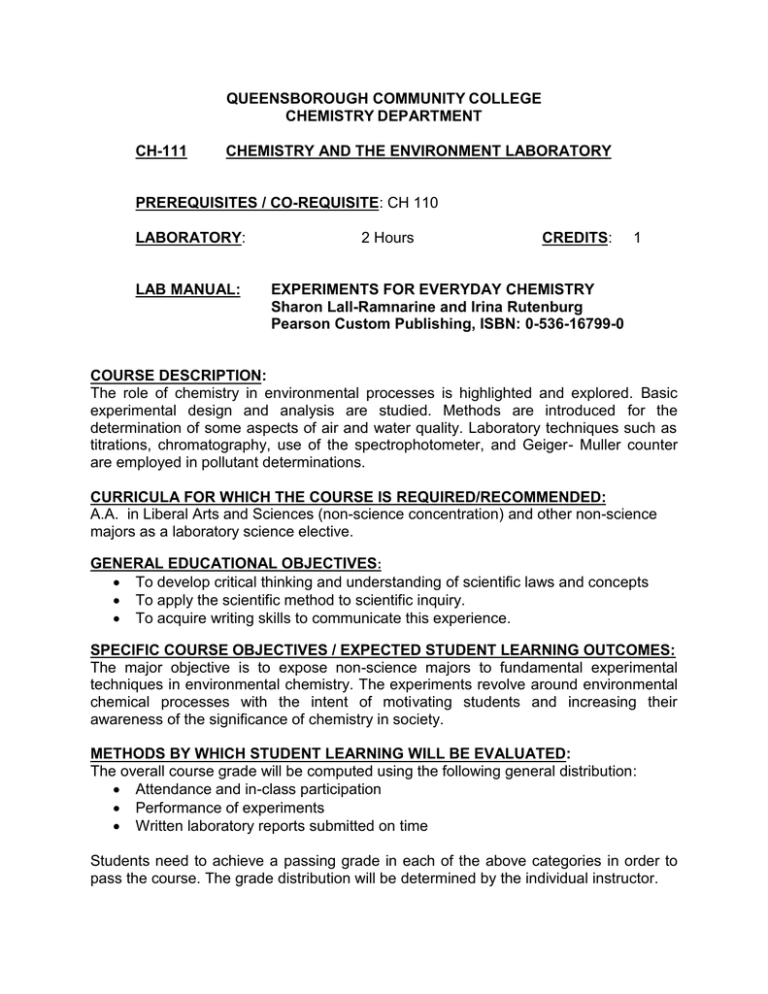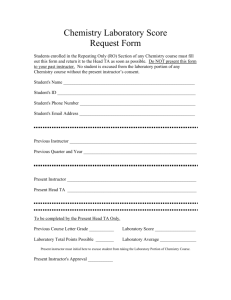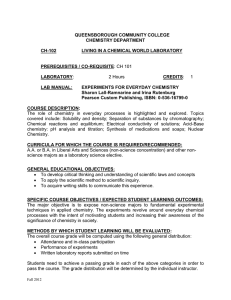QUEENSBOROUGH COMMUNITY COLLEGE CHEMISTRY DEPARTMENT CH-111 CHEMISTRY AND THE ENVIRONMENT LABORATORY
advertisement

QUEENSBOROUGH COMMUNITY COLLEGE CHEMISTRY DEPARTMENT CH-111 CHEMISTRY AND THE ENVIRONMENT LABORATORY PREREQUISITES / CO-REQUISITE: CH 110 LABORATORY: LAB MANUAL: 2 Hours CREDITS: 1 EXPERIMENTS FOR EVERYDAY CHEMISTRY Sharon Lall-Ramnarine and Irina Rutenburg Pearson Custom Publishing, ISBN: 0-536-16799-0 COURSE DESCRIPTION: The role of chemistry in environmental processes is highlighted and explored. Basic experimental design and analysis are studied. Methods are introduced for the determination of some aspects of air and water quality. Laboratory techniques such as titrations, chromatography, use of the spectrophotometer, and Geiger- Muller counter are employed in pollutant determinations. CURRICULA FOR WHICH THE COURSE IS REQUIRED/RECOMMENDED: A.A. in Liberal Arts and Sciences (non-science concentration) and other non-science majors as a laboratory science elective. GENERAL EDUCATIONAL OBJECTIVES: To develop critical thinking and understanding of scientific laws and concepts To apply the scientific method to scientific inquiry. To acquire writing skills to communicate this experience. SPECIFIC COURSE OBJECTIVES / EXPECTED STUDENT LEARNING OUTCOMES: The major objective is to expose non-science majors to fundamental experimental techniques in environmental chemistry. The experiments revolve around environmental chemical processes with the intent of motivating students and increasing their awareness of the significance of chemistry in society. METHODS BY WHICH STUDENT LEARNING WILL BE EVALUATED: The overall course grade will be computed using the following general distribution: Attendance and in-class participation Performance of experiments Written laboratory reports submitted on time Students need to achieve a passing grade in each of the above categories in order to pass the course. The grade distribution will be determined by the individual instructor. CH-111 CHEMISTRY AND THE ENVIRONMENT LABORATORY ATTENDANCE/ABSENCE POLICY: All lab policies will be explained in detail by your lab instructor. Three (3) or more absences from the lab earn a grade of WU in the lab. The first and last lab meetings are mandatory and count against your total attendance. There are no make-up sessions for missed labs. Policies regarding excused and unexcused absences will be explained by your lab instructor. A full lab report is required for each experiment and is due the next class period. Your lab instructor will describe the format for lab reports, as well as requirements for entry into the lab. Students who arrive after the pre-lab lecture may not participate and will be marked absent. Safety in the lab is extremely important. Therefore, the ACS safety video must be viewed during the first lab session. A safety quiz must be taken and passed, and the safety declaration sheet must be signed. A student that shows up for the lab, but who has not seen the safety video and passed the quiz, will not be permitted to conduct the experiment, will be considered absent, and will receive a zero for the lab. There will be several additional showings of the safety video during the first three weeks of classes. A student who has not viewed the safety video and passed the quiz by the third lab session will have accumulated 3 absences in the lab and therefore will not be permitted to continue in the course. They may either withdraw or receive a WU for the course. REQUIRED ATTIRE: Students MUST wear safety goggles in the laboratory at all times. Failure to do so may lead to their expulsion from the laboratory and failure of the laboratory class. Unacceptable attire include: sandals or open-shoes, shorts and tops exposing midriff, and untied long hair. In addition, any type of food or beverage is forbidden in the laboratory. ACADEMIC INTEGRITY: Academic honesty is taken extremely seriously and is expected of all students. All assignments must be the original work of the student (and partners or group, if applicable). All questions or concerns regarding ethical conduct should be brought to the course instructor. “It is the official policy of the College that all acts or attempted acts that are violations of academic integrity be reported to the Office of Student Affairs (OSA). At the faculty member’s discretion and with the concurrence of the student or students involved, some cases, though reported to the OSA, may be resolved within the confines of the course and department. The instructor has the authority to adjust the offender’s grades as deemed appropriate, including assigning an F to the assignment or exercise or, in more serious cases, an F to the student for the entire course” (Adopted from the QCC Academic Integrity Policy, 2/14/2005). ACCOMMODATIONS FOR STUDENTS WITH DISABILITIES: As stated in the current college catalog, any student who needs specific accommodations based upon the impact of a disability should register with the office of Services for Students with Disabilities (SSD) to be eligible for accommodations which are determined on an individual basis. The SSD office is located in the Science Building, room S132 (718-631-6257). Students should also contact their instructor privately to discuss their specific needs. CH-111 LAB MANUAL: Wk. # 1 Expt. # 2 CHEMISTRY AND THE ENVIRONMENT LABORATORY EXPERIMENTS FOR EVERYDAY CHEMISTRY Sharon Lall-Ramnarine and Irina Rutenburg ISBN: 0-536-16799-0 Experiment Title Page Safety in the laboratory and Check-in 1 1 Physical Properties of Substances: Solubility and Density 3 3 2 Separation of Substances: Chromatography 7 4 3 Chemical properties of Substances: Chemical Reactions 13 5 4 Chemical Equilibrium and Le Chatelier's Principle 19 6 5 Electrical Conductivity of Solutions: Electrolytes and Non-electrolytes 25 33 7 6 Qualitative Analysis: Test for Unknown Ions 8 7 Quantitative Analysis: Determination of the Salinity of Water 41 9 8 Quantitative Analysis of Cigarettes 45 10 9 Analysis of Car Exhaust Fumes I (Calibration Curve) 51 11 10 Analysis of Car Exhaust Fumes II (Amount of nitrogen dioxide) 55 12 12 pH Determination of Solutions: Acidity of Water (Part I: Titration) 13 12 pH Determination of Solutions: Acidity of Water (Part II: use of a pH meter) 65 Nuclear Chemistry: Radioactivity and Check-out 97 14 18 65


